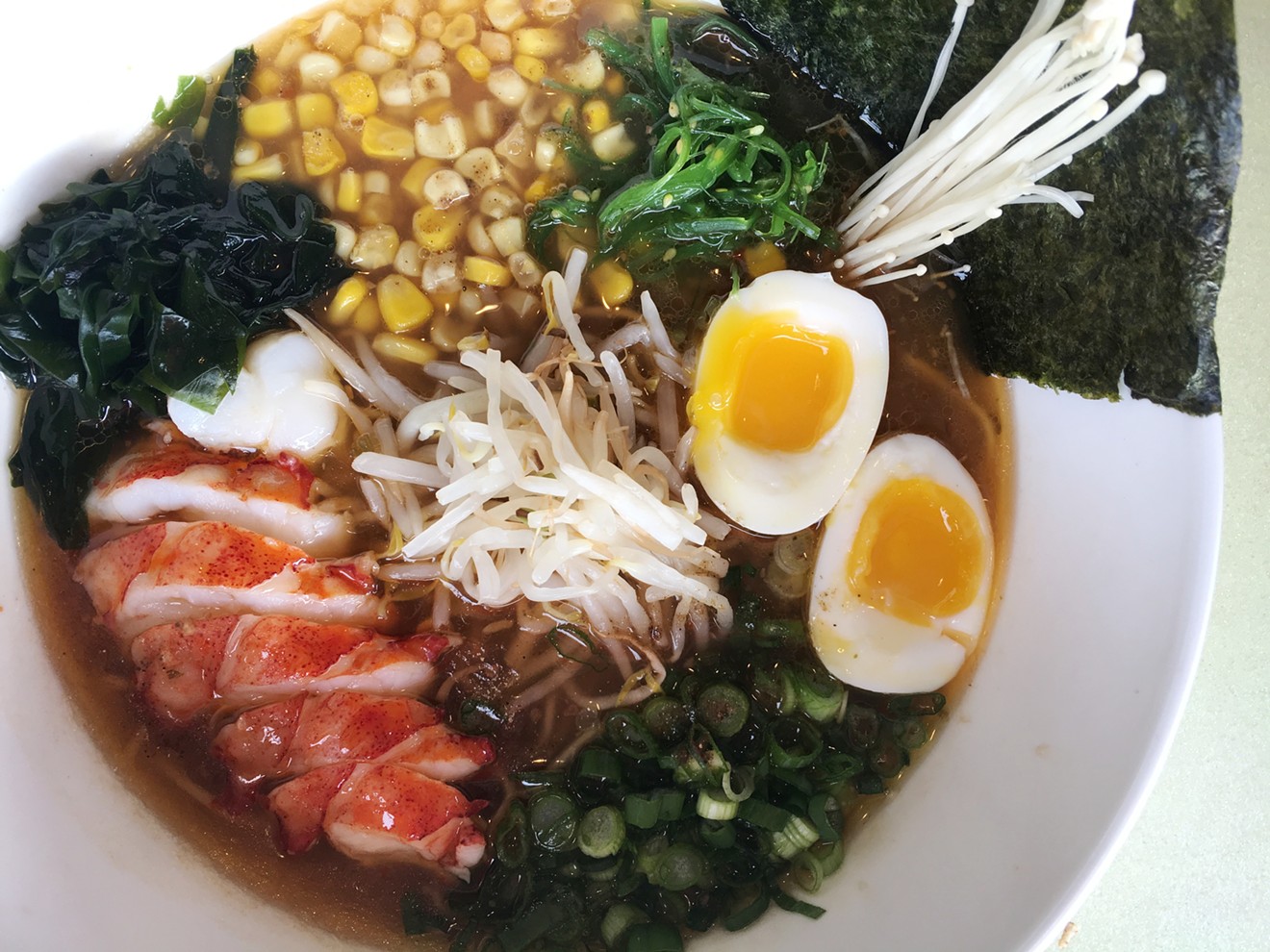Zoe was born in Taiwan and worked in his parents' restaurants in Washington, D.C., and the Midwest, starting as a coat-check boy for 25 cents a coat and eventually learning every station. After college, he ran his own software company. But after his father passed away, he opened Zoe Ma Ma in Boulder in 2010 with his mother, serving the traditional Chinese food he'd grown up eating.

Chimera's lobster ramen is one of four styles on the menu that contain housemade noodles.
Mark Antonation
After adding a second Zoe Ma Ma next to Denver's Union Station in 2014, last spring the restaurateur launched Chimera, a pan-Asian eatery specializing in the favorite dishes of his childhood and traveling experiences. And he's not leaving anything to chance: Zoe spends a couple of hours at Chimera every day making noodles for the four ramen styles that have become increasingly popular at the restaurant. What started as a passion project has grown into the eatery's top seller; Chimera's customers gulp down 100 to 200 bowls of ramen a day.
As a result, Zoe has stepped up his noodle-making. "The demand got to the point where we had to look at scaling up production," he explains.

Chimera owner Edwin Zoe positions rolls of ramen dough in the noodle machine he purchased from a Japanese company.
Mark Antonation
Since Chimera opened, those noodles have always been made by hand in small batches. "Using frozen factory noodles just isn't part of who I am or what I wanted to do," Zoe says. After all, the noodles and dumplings at Zoe Ma Ma are all made by hand, mostly by his 76-year-old mother, who still works twelve-hour days.
So instead of bringing in a purchased product, Zoe and his team decided to use an electric sheeter to roll out the homemade dough before feeding the sheets through another machine to cut them into the right width. But the process became more and more time-consuming as demand escalated.
Early this year, Zoe made the leap to more automated production by purchasing a noodle machine from Japan. "The air freight alone was over $5,000," he notes, and the machine itself rang in at about the same price as a new SUV. The recipe has remained mostly the same throughout, even with the new equipment: just organic flour, water, salt, a little egg white and the crucial ingredient, soda ash, which adds alkalinity, giving the finished noodles the bounce that's critical to an enjoyable bowl of ramen. A batch of dough is mixed for about ten minutes and allowed to rest for at least an hour to properly hydrate the flour, then loaded into the noodle machine's hopper. At this point, the dough is crumbly and sticky, so Zoe must massage it to a sandy consistency as it feeds through the rollers. Skipping this step would result in air pockets in the dough sheets.
A big part of why the machine was so expensive is its precision when rolling and cutting dough. A dial on the side must be turned a full 360 degrees just to change the thickness of the rolled sheet by a tenth of a millimeter, and the manufacturer sent along a separate micrometer that Zoe uses to measure the final product to ensure that the machine is maintaining its accuracy. After the initial pass, the dough must be rolled several more times, including two laminations (during which two separate sheets of dough are pressed together by the rollers), while the last pass presses the dough to its final thickness and cuts it into noodles just the right length and width. Each pass through the roller requires human intervention, and Zoe or his kitchen manager also have to play catcher at the end, bundling the cut noodles into 100 separate nests, each the perfect size for a bowl of ramen.
As Zoe watches the roll of sheeted dough increase in width around its dowel (it looks like a roll of paper towels), he points to the striations that give it the appearance of birch bark, explaining that the stripes are caused by different hydration levels in the dough. Multiple passes integrate the streaks and give the finished product strength and stretch. The entire process takes about an hour, and on busy days it must be completed twice. Not surprisingly, Zoe is confident that no other restaurant in the metro area is putting such care into ramen.
That care extends beyond the noodles. Chimera makes its house ramen, spicy red ramen, vegetarian miso ramen and butter-poached-lobster ramen using long-simmered broths as the base, then adds a "tare," a powerful seasoning paste, to boost the flavor of each bowl. While sticking mostly with traditional toppings — pork belly roasted in-house, enoki mushrooms, nori seaweed and ajitsuke tamago (marinated eggs), for example — he does deviate with one specific ingredient: corn.
"Corn is usually served with miso ramen in Hokkaido, but I just loved corn so much growing up," he says. "In Taiwan at the time, it was considered a luxury ingredient." And so corn, dripping with the butter in which the lobster meat was poached, is included atop all of Chimera's offerings.
Zoe has studied the evolution of Chinese lamian into the many varieties of Japanese ramen, and he's visited Japan on numerous occasions, eating at the best ramen-yas in multiple cities. He has also studied the dish in New York City's finest noodle shops. He's obsessed with the exact salinity of the broth, the texture of the noodles, the complexity of the overall experience achieved from the balance of ingredients.
At Chimera, you can share Zoe's obsession — down to the last slurp.
Chimera is located at 2014 Tenth Street in Boulder and is open for lunch (11 a.m to 2 p.m. Monday through Friday) and dinner ( 4 to 10 p.m. daily). Call 720-580-1100 or visit the restaurant's website for more details.














